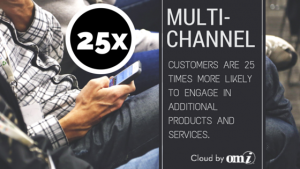Making the Move to Multi-Channel
Why should you make the move to multi-channel customer communications? Here’s why: Over 750 million users use Facebook every single day. Over 6,000 “tweets” are issued every second. And nearly one third of all web traffic comes through mobile phones. Clearly, the days of communicating via plain old paper are over, so the question becomes: Are you ready to make the move to multi-channel?
Multiple Reasons for Multi-Channel
Companies that continue to rely on print to communicate with customers will find it increasingly difficult, if not impossible, to keep up. According to recent studies, 72% of consumers want only to interact with a brand via social media channels. And findings indicate that 44% of email recipients made at least one purchase last year based on a promotional email. Since over half of American adults have a smartphone, and most check for messages even when they don’t notice their phone ringing, if you have been late to adopt multi-channel you have been missing out on a great deal of opportunity.
Consumers Expect Multi-Channel
These days, customers have come to expect a multi-channel experience. We want more choices and wider flexibility in terms of how we receive information and interact with a company. As a result, organizations that continue to be paper-bound are seen as behind the times, especially among millennial consumers. According to Edison Research, 66% of 18-24 year-olds are more loyal to companies they interact with through social media and online. Are you at risk of being left behind?
Multi-Channel Marketing Value
Multi-channel is more than simply as a delivery mechanism; it’s also a perfect match for personalized campaigns and marketing messages. Companies are finding great marketing value across multiple customer touch points (e.g., bills and statement as well as social media or online communications channels). Whereas cross-selling or up-selling was once a low-percentage proposition — junk mail and “stuffers” return well below 1% — multi-channel customers are 25 times more likely to engage in additional products and services. Is now the time to engage customers with multi-channel marketing?
Moving Forward with Multi-Channel
Organizations often struggle with multi-channel message consistency due to internal processes and systems that are not in sync. Select solutions that bring both the technology and the strategy together in a ways that will be successful. There should be no guesswork regarding what communications were sent, opened or interacted with so you can direct your efforts in ways that maximize your return — and your customer’s overall experience. Look for a single source approach to multi-channel communications and campaigns that will help you gain immediate as well as long-term business results.